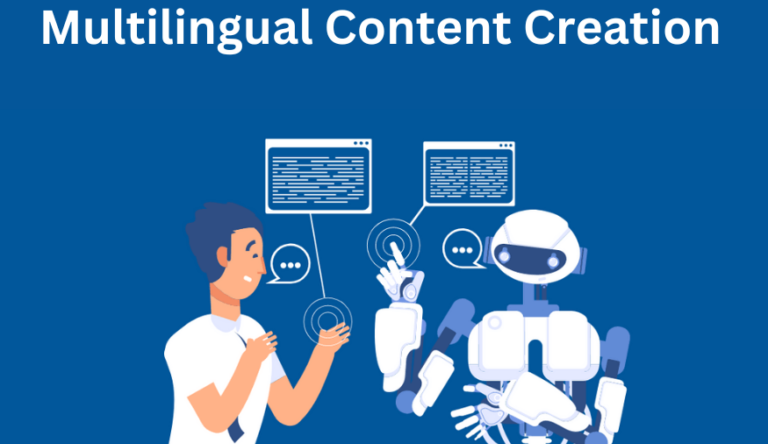In today’s globalized world, having a multilingual content strategy can make all the difference in reaching a wider audience and expanding your brand’s reach. However, creating and maintaining multilingual content can be a time-consuming and costly endeavor, especially if you have limited resources.
Fortunately, advancements in AI solutions and machine translation such as this have made it easier than ever to optimize your multilingual content strategy. By leveraging these technologies, you can streamline your translation and localization processes while maintaining the quality of your content.
Key Components of Multilingual Content Strategy

Translation and localization are key components of any multilingual content strategy. Translation involves taking content in one language and converting it into another language, while localization involves adapting the translated content to suit the cultural and linguistic nuances of the target audience. Both are critical for creating effective multilingual content that resonates with your audience.
Traditionally, translation and localization were done manually by human translators, which was a time-consuming and expensive process. However, with the advent of machine translation and AI solutions, this process has become much more efficient.
Machine translation involves using software to automatically translate content from one language to another. While machine translation is not perfect and can sometimes produce inaccurate translations, it has come a long way in recent years and can be a useful tool for quickly translating large amounts of content.
AI solutions can also be used to optimize the translation and localization process. For example, AI-powered translation tools can learn from previous translations to improve accuracy and consistency over time. AI-powered content management systems can also help streamline the localization process by automating tasks such as formatting and image replacement.

When implementing machine translation and AI solutions into your multilingual content strategy, it’s important to keep in mind that these tools are not a replacement for human translators and localization experts. While these technologies can help streamline the process, they should be used in conjunction with human expertise to ensure the quality and accuracy of your content.
Another important factor to consider when implementing a multilingual content strategy is the cultural nuances and preferences of your target audience. In some cases, simply translating content word-for-word may not be enough to effectively engage with your audience.
For example, certain phrases or cultural references may not translate well into another language or may have a different connotation. Localization experts can help identify these potential issues and adapt the content accordingly to ensure that it resonates with the target audience.
Furthermore, it’s important to consider the different languages and dialects that exist within a given language. For example, Spanish is spoken in many different countries, each with their own unique dialect and cultural nuances. By tailoring your content to specific regions or countries, you can create a more personalized and effective multilingual content strategy.
Another advantage of using machine translation and AI solutions is the ability to quickly update and adapt your content to changing market conditions or trends. This is particularly important in industries such as e-commerce, where timely updates and localized content can make a significant impact on sales and customer engagement.
Overall, a well-executed multilingual content strategy can help businesses expand their reach and connect with new audiences. By leveraging machine translation and AI solutions, businesses can streamline the translation and localization process while maintaining the quality of their content. However, it’s important to balance the use of technology with human expertise to ensure that the content effectively resonates with the target audience.
Measuring the Success of Your Multilingual Content Strategy

Here are some key steps and metrics to consider when measuring the success of your multilingual content strategy:
- Set Clear Objectives: Begin by defining clear and specific objectives for your multilingual content strategy. These objectives should align with your overall business goals and take into account factors such as audience engagement, website traffic, conversions, brand awareness, customer satisfaction, or any other relevant metrics. Clear objectives provide a benchmark against which you can measure the success of your strategy.
- Track Website Traffic: Monitor the traffic to your multilingual website or localized content to gauge its performance. Use web analytics tools like Google Analytics or similar platforms to track the number of visitors, page views, time spent on each page, bounce rates, and other relevant metrics. Comparing the performance of different language versions of your website can help identify which languages or regions are driving the most engagement.
- Analyze Conversion Rates: Conversion rates are a crucial indicator of how well your multilingual content is resonating with your audience and driving desired actions. Track conversions such as product purchases, form submissions, newsletter sign-ups, or any other goals specific to your business. Analyze conversion rates for different language versions to identify patterns, trends, and areas for improvement.
- Engagement Metrics: Assess the level of audience engagement with your multilingual content. Analyze metrics such as time spent on page, scroll depth, social media shares, comments, or any other indicators of user engagement. These metrics can help you understand the effectiveness of your content in capturing and retaining the attention of your multilingual audience.
- Social Media Reach: Evaluate the reach and engagement of your multilingual content on social media platforms. Track metrics such as likes, shares, comments, and follower growth for each language-specific social media account. This data can provide insights into the effectiveness of your social media content strategy and help identify which languages or regions are most active and responsive.
- Customer Feedback and Surveys: Actively seek feedback from your multilingual audience to understand their perception of your content. Utilize customer surveys, feedback forms, or user testing to gather insights on the clarity, relevance, and effectiveness of your multilingual content. Feedback from your audience can help identify areas for improvement and guide your content optimization efforts.
- Localization Quality: Assess the quality of your multilingual content and its alignment with the cultural and linguistic nuances of different regions. Monitor and analyze user feedback, reviews, or ratings specific to each language version. Consider conducting periodic quality checks and audits to ensure consistency, accuracy, and cultural appropriateness across all language versions.
Conclusion

In conclusion, optimizing your multilingual content strategy with machine translation and AI solutions can help streamline the translation and localization process while maintaining the quality of your content. By leveraging these technologies, you can expand your brand’s reach and connect with a wider audience. However, it’s important to use these tools in conjunction with human expertise to ensure the accuracy and effectiveness of your content.
Related Posts:
- 20 Best Gaming Headset Under 50$ 2024 - for PC, PS4,…
- Top 10 Best Office Chair Under 200 2024 - Ergonomic…
- Top 10 Best Power Inverter for Car 2024 - Keep Your…
- 15 Best Shoes for Walking on Concrete 2024 - Soft &…
- Top 10 Best Leather Backpack For Men and Women 2024…
- Top 16 Best Office Chair Covers 2024 - Chair…







